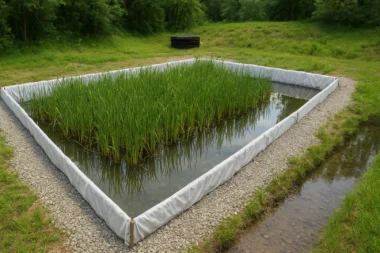Introduction
In the quest for sustainable water management practices, aquifer storage and recovery (ASR) emerges as a promising solution to address the challenges of water scarcity, seasonal variability, and increasing demand for freshwater resources. ASR represents a proactive approach to water storage and management, leveraging natural underground reservoirs to store surplus water during periods of abundance and recover it during times of need.
Principle of ASR
The principle of Aquifer Storage and Recovery (ASR) revolves around utilizing natural underground aquifers as storage reservoirs for surplus water during times of abundance and recovering stored water during periods of water scarcity or increased demand. This process involves injecting treated water into suitable aquifers for storage and later withdrawing it for various uses, such as drinking water supply, irrigation, or industrial purposes. The key principles of ASR include:
- Storage Capacity: ASR relies on the ability of aquifers to store surplus water effectively. Aquifers are porous geological formations capable of holding significant volumes of water within their pore spaces and fractures. The storage capacity of an aquifer depends on its porosity, permeability, and hydraulic conductivity.
- Injection and Recovery Wells: ASR systems utilize injection wells to deliver surplus water into the aquifer and extraction wells to recover stored water when needed. These wells are strategically located and designed to facilitate the injection and extraction processes efficiently. Injection wells must be properly sealed to prevent leakage and ensure the integrity of the aquifer.
- Hydrogeological Considerations: Successful implementation of ASR projects requires a thorough understanding of hydrogeological factors such as groundwater flow patterns, recharge rates, aquifer characteristics, and geochemical interactions. Hydrogeological assessments help identify suitable aquifers for storage, predict water storage and recovery rates, and assess potential impacts on groundwater quality.
- Water Quality Monitoring and Treatment: Water quality monitoring is essential throughout the ASR process to ensure that the stored water meets regulatory standards and is safe for its intended use. Water quality parameters such as pH, turbidity, dissolved oxygen, and microbial content are monitored regularly. Treatment processes such as filtration, disinfection, and pH adjustment may be employed to maintain water quality during storage and recovery.
- Regulatory Compliance: ASR projects must comply with regulatory requirements governing water abstraction, injection, and water quality standards. Regulatory agencies establish guidelines and permit conditions to ensure the protection of groundwater resources, public health, and the environment. Compliance with regulatory standards is essential to obtaining permits and approvals for ASR operations.
- Environmental Considerations: ASR projects must consider potential environmental impacts on groundwater resources, ecosystems, and surrounding communities. Environmental assessments evaluate potential risks such as aquifer overexploitation, groundwater contamination, and habitat disturbance. Mitigation measures are implemented to minimize adverse impacts and protect natural resources.
- Monitoring and Evaluation: Continuous monitoring and evaluation of ASR operations are necessary to assess system performance, track water storage and recovery rates, and identify any operational issues or potential improvements. Monitoring data are used to optimize system efficiency, ensure water quality compliance, and adapt to changing hydrological conditions.
By adhering to these principles and integrating best practices, ASR offers a sustainable and flexible solution for water storage and management, contributing to water security, resilience, and resource optimization in diverse hydrological settings.
The working process of ASR
- Assessment and Site Selection: The process begins with comprehensive hydrogeological assessments to identify suitable aquifers for storage. Factors such as aquifer characteristics, hydraulic conductivity, porosity, and water quality are evaluated. Suitable injection and extraction well locations are also determined based on these assessments.
- Injection of Surplus Water: During periods of water abundance, surplus water from various sources, such as rivers, lakes, or treated wastewater, is treated to meet regulatory standards and injected into selected aquifers. Injection wells equipped with pumps deliver the treated water into the aquifer at controlled rates and pressures.
- Storage in the Aquifer: Once injected, the surplus water infiltrates into the pore spaces and fractures of the aquifer, where it is stored underground. The stored water forms a reserve within the aquifer, ready to be recovered when needed. The natural geological formations act as a natural barrier, preventing the stored water from mixing with existing groundwater.
- Water Quality Monitoring and Treatment: Throughout the storage period, water quality is monitored to ensure compliance with regulatory standards. Monitoring parameters such as pH, turbidity, dissolved oxygen, and microbial content are regularly assessed. Treatment processes such as filtration, disinfection, and pH adjustment may be employed as needed to maintain water quality.
- Recovery of Stored Water: During periods of water scarcity or increased demand, stored water is recovered from the aquifer by extracting it through dedicated extraction wells. Extraction wells are strategically located to optimize water recovery rates. Pumps are used to draw water from the aquifer to the surface, where it undergoes further treatment, if necessary, before distribution.
- Distribution and Utilization: The recovered water is treated to meet drinking water standards or other specific requirements and distributed to end-users through existing water supply systems. Depending on local needs, recovered water may be used for drinking water supply, irrigation, industrial processes, or environmental restoration.
- Monitoring and Evaluation: Continuous monitoring and evaluation of ASR operations are essential to assess system performance, track water storage and recovery rates, and identify any operational issues or potential improvements. Monitoring data are used to optimize system efficiency, ensure water quality compliance, and adapt to changing hydrological conditions.
Techniques used
- Injection Wells: Injection wells are drilled into suitable aquifers for the purpose of delivering surplus water for storage. These wells are designed with appropriate casing and screens to prevent contamination and ensure efficient injection of water into the aquifer.
- Extraction Wells: Extraction wells are used to recover stored water from the aquifer when needed. These wells are strategically located to optimize water recovery rates and are equipped with pumps to draw water from the aquifer to the surface.
- Hydrogeological Assessments: Comprehensive hydrogeological assessments are conducted to evaluate aquifer characteristics, including porosity, permeability, hydraulic conductivity, and water quality. These assessments help identify suitable aquifers for storage and determine the feasibility of ASR projects.
- Water Treatment: Prior to injection, surplus water is treated to meet regulatory standards and ensure its compatibility with the receiving aquifer. Treatment processes may include filtration, disinfection, pH adjustment, and the removal of contaminants to improve water quality.
- Monitoring and Control Systems: ASR systems are equipped with monitoring and control systems to track water levels, pressure, and quality in real-time. These systems allow operators to optimize injection and recovery rates, detect potential issues, and ensure compliance with regulatory requirements.
- Water Quality Monitoring: Continuous monitoring of water quality is essential throughout the ASR process to ensure that stored water meets regulatory standards and is safe for its intended use. Parameters such as pH, turbidity, dissolved oxygen, and microbial content are regularly monitored and analyzed.
- Geophysical Surveys: Geophysical surveys, including seismic surveys, electrical resistivity imaging, and ground-penetrating radar, may be conducted to characterize subsurface geological formations and identify potential aquifer storage zones.
- Modeling and Simulation: Computer modeling and simulation tools are used to predict groundwater flow patterns, assess storage capacity, and optimize injection and recovery strategies. These tools help improve the efficiency and effectiveness of ASR operations.
- Regulatory Compliance: ASR projects must comply with regulatory requirements governing water abstraction, injection, and water quality standards. Regulatory agencies establish guidelines and permit conditions to ensure the protection of groundwater resources, public health, and the environment.
Case study: Aquifer Storage and Recovery in the Semi-Arid Region
Background: The semi-arid region in question experiences limited rainfall and relies heavily on groundwater for agricultural, industrial, and domestic purposes. However, groundwater levels fluctuate significantly due to seasonal variations and over-extraction, leading to water shortages during dry periods.
Objectives: The primary objective of the ASR project is to enhance water security and resilience by utilizing natural underground aquifers to store surplus water during wet seasons and recover it during dry periods. The project aims to stabilize groundwater levels, improve water availability, and reduce reliance on surface water sources.
Implementation:
- Site Selection: Hydrogeological assessments are conducted to identify suitable aquifers for storage based on factors such as porosity, permeability, and hydraulic conductivity. A shallow alluvial aquifer is identified as the most suitable candidate due to its high storage capacity and proximity to water sources.
- Injection and Recovery Wells: Injection and recovery wells are drilled into the selected aquifer, strategically located to optimize water storage and recovery rates. Injection wells are equipped with pumps to deliver surplus water for storage, while extraction wells are used to recover stored water when needed.
- Water Treatment: Surplus water from nearby rivers and treated wastewater are treated to meet regulatory standards before injection into the aquifer. Treatment processes include filtration, disinfection, and pH adjustment to improve water quality and prevent aquifer contamination.
- Monitoring and Control Systems: The ASR system is equipped with monitoring and control systems to track water levels, pressure, and quality in real-time. Sensors installed in injection and extraction wells provide continuous data on aquifer conditions, allowing operators to optimize injection and recovery rates.
Results:
- Water Storage: The ASR project successfully stores surplus water in the aquifer during wet seasons, increasing groundwater levels and replenishing depleted reserves.
- Water Recovery: During dry periods, stored water is recovered from the aquifer to supplement water supply, reducing reliance on surface water sources and mitigating the impacts of water scarcity.
- Improved Water Availability: The ASR project improves water availability for agricultural irrigation, industrial processes, and domestic consumption, supporting economic growth and community development in the region.
- Environmental Benefits: By reducing groundwater overdraft and minimizing reliance on surface water diversions, the ASR project helps protect natural ecosystems and habitats dependent on stable water supplies.
Conclusion: The ASR project demonstrates the effectiveness of utilizing aquifers for water storage and management in semi-arid regions. By leveraging natural underground reservoirs, the project enhances water security, resilience, and sustainability, contributing to the long term viability of water resources in the region.



